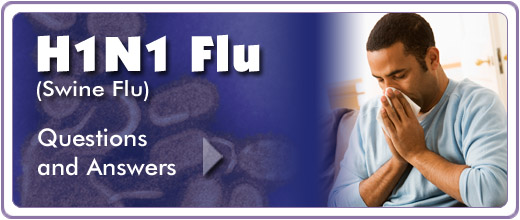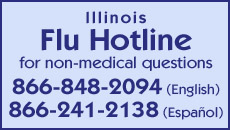
|

www.flu.gov
U.S. Department of
Health & Human Services’
influenza Web site
| Illinois H1N1 Flu Case Summary |
| Counties |
Confirmed and Probable Cases |
Deaths |
| 42 |
3,425 |
17 |
Illinois Cases of H1N1 Flu by County
(As of July 31, 2009, 10 a.m.)
Updated on Fridays |
City or
County |
# of
Probable Cases |
# of
Confirmed Cases |
Total |
| Boone |
- |
10 |
10 |
| Champaign |
- |
1 |
1 |
| Chicago |
9 |
1,574 |
1,583 |
| Coles |
- |
1 |
1 |
| Cook |
17 |
972 |
989 |
| DeKalb |
- |
2 |
2 |
| DeWitt |
- |
1 |
1 |
| DuPage |
- |
147 |
147 |
| Effingham |
- |
2 |
2 |
| Fayette |
- |
1 |
1 |
| Franklin |
- |
2 |
2 |
| Grundy |
- |
2 |
2 |
| Henry |
- |
2 |
2 |
| Jackson |
- |
1 |
1 |
| Jo Daviess |
- |
1 |
1 |
| Kane |
5 |
86 |
91 |
| Kankakee |
1 |
28 |
29 |
| Kendall |
- |
6 |
6 |
| Knox |
- |
3 |
3 |
| Lake |
5 |
249 |
254 |
| LaSalle |
- |
8 |
8 |
| Madison |
- |
5 |
5 |
| McDonough |
- |
3 |
3 |
| McHenry |
- |
14 |
14 |
| McLean |
- |
2 |
2 |
| Mercer |
1 |
2 |
3 |
| Monroe |
- |
1 |
1 |
| Ogle |
- |
4 |
4 |
| Peoria |
- |
3 |
3 |
| Piatt |
- |
1 |
1 |
| Putnam |
- |
1 |
1 |
| Richland |
- |
2 |
2 |
| Rock Island |
- |
24 |
24 |
| Sangamon |
- |
3 |
3 |
| St. Clair |
- |
4 |
4 |
| Stephenson |
- |
3 |
3 |
| Tazewell |
- |
1 |
1 |
| Union |
- |
1 |
1 |
| Warren |
- |
2 |
2 |
| Whiteside |
- |
2 |
2 |
| Will |
- |
152 |
152 |
| Williamson |
- |
5 |
5 |
| Winnebago |
- |
47 |
47 |
| Undetermined |
- |
6 |
6 |
| Total |
38 |
3,387 |
3,425 |
Locations may change as the result of additional information obtained through case investigations.
A confirmed case is defined as a person with an acute febrile respiratory illness with laboratory confirmed infection.
A probable case is defined as a person with an acute febrile respiratory illness who is positive for influenza A, but negative for H1 and H3.
The reported number of " probable and confirmed" cases do not reflect the overall incidence of H1N1 influenza in Illinois because CDC and the Illinois Department of Public Health are not emphasizing testing of patients with mild illness. Most individuals with novel influenza H1N1 infection have mild illness and are not being tested.
Since the number of Illinois cases listed represent a weekly update, the totals may not always be consistent with those reported by local health departments. If there is a discrepancy between the state and local health department counts, data from the local health departments should be used as the most accurate number.
|

|
|


